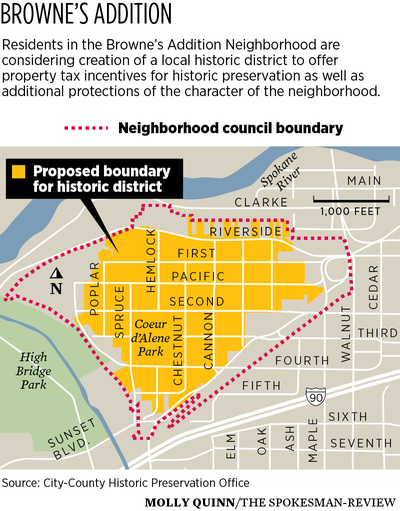Eclectic vibe of Browne’s Addition at heart of effort to create historic district

Three years ago, three old homes in Spokane’s Browne’s Addition neighborhood were demolished. They sat on Coeur d’Alene Street, with a view over the edge of the neighborhood, where it drops off into Hangman Valley.
In their place, a Seattle-based developer built what it called 317 CDA, a 21-unit modern apartment complex that offers “luxury living in Spokane’s historic Browne’s Addition,” where two-bedroom apartments go for $1,750 a month. The angular, three-story building, monumental and new, dominates the triangular corner lot.
The development, which brought more density and high-cost living to the neighborhood, was “frustrating,” said Rick Biggerstaff, chair of the neighborhood council.
“He’s a property owner. He can do what he wants,” Biggerstaff said. “But what often happens is the conversation from the developer is how great it is for our neighborhood. My thinking is, you never come and ask us. You tell us you’re doing a great thing for our neighborhood without ever asking us. There’s no conversation.”
Now, 274 property owners in the neighborhood have a chance to force a conversation. Ballots have gone out to these property owners, asking if the neighborhood should become a historic district, which comes with stiffer development regulations but also financial incentives aimed at rehabilitation.
A majority vote of property owners have to approve the district, and ballots have to be in the city’s hands by Aug. 22 to count. If approved, any demolition, construction, renovation or changes to a building’s exterior in the neighborhood would be reviewed by the city’s Historic Preservation Office. Minor changes, like in paint color and landscaping, would not be subject to review.
Biggerstaff said the proposed historic district would “not necessary have stopped” the development that spurred the ban in the first place.
“I think all the houses that came down would’ve come down. The developments would still be there. But they wouldn’t look like what they look like,” he said. “This forces a conversation.”
Creation of the historic district would preserve the character of the neighborhood, said Logan Camporeale, the city’s historic preservation specialist.
“It’s an eclectic neighborhood,” he said, noting that the effort to create the historic district originated with the neighborhood council, not the city. “A mix. It has apartments, and it has houses.”
Browne’s Addition, the city’s oldest residential neighborhood, was a favorite locale for successful business tycoons near the turn of the 20th century, in the city’s early days. The neighborhood features a mix of architectural styles, from Queen Anne Victorian mansions built in the late 1800s to apartment buildings erected in the 1960s and ’70s. The neighborhood has been on the largely honorific National Register of Historic Places since 1976.
Protecting the historic housing stock and character of the neighborhood is key, Camporeale said. Following the demolition of numerous old houses, including the three that spurred the current effort, the city placed a moratorium on demolition in Browne’s Addition in 2017. Also razed was a historic home at Second Avenue and Chestnut Street near Coeur d’Alene Park, to make way for a 13-unit apartment building.
Spokane City Councilwoman Lori Kinnear was behind the ban to prevent the “clear cutting of Browne’s Addition” after the neighborhood approached her, she said.
“The neighborhood council came to me and said, ‘What can we do? We want to see what avenues are open to us,’” Kinnear said. She said she first explored a demolition ban in 2009, when she worked as a legislative aide to Councilwoman Amber Waldref.
“Mary Verner just dropped it cold,” Kinnear said of the mayor at the time. “We picked it up where we left off.”
Kinnear and the city let the demolition ban expire after a year. Camporeale said a demolition prohibition wasn’t the preferred method for preserving Browne’s historic buildings.
“It’s all stick and no carrot,” he said, noting that the historic district still has “lots of teeth.” He added, “This has some give and take, and that’s critical.”
For the 274 owners of 372 parcels in the district, the carrot comes with three significant incentive opportunities made available by the creation of the historic district.
First, homeowners renovating their buildings could qualify for a special valuation tax, which would reduce their property taxes for 10 years based on the cost of restoration.
Second, a national Historic Tax Credit provides a 20% income tax credit to developers of income-producing properties, like retail establishments and rental apartments, of which there are many in Browne’s.
The national tax credit was created in 1976 and is “one of the most powerful historic preservation tools we have,” according to the National Conference of State Historic Preservation Officers, which said the tax credit has preserved more than 42,000 buildings and generated $84 billion in economic development since its inception.
Combined, the special tax valuation and tax credit could “erase taxes altogether” for commercial property owners, Camporeale said.
Finally. there’s the Facade Improvement Grant, a local incentive funded through the fees the city charges for demolition permits. Last year, two projects received $7,500 in these grants for work on the Garland Theater and the Kehoe Block in Hillyard. The same program was used during the North Monroe Street revitalization, which generated in $250,000 in improvements.
Biggerstaff said the historic district would not only help preserve the neighborhood’s historic character, but also its mixed-income nature.
“We’re not trying to build a wall around our neighborhood. We want people in our neighborhood,” Biggerstaff said. “I’ve seen the poorest people in this neighborhood and I’ve seen the wealthiest people in this neighborhood. That’s Browne’s Addition. We want diversity. This has to be the most diverse neighborhood in Spokane. We don’t want that to change.”